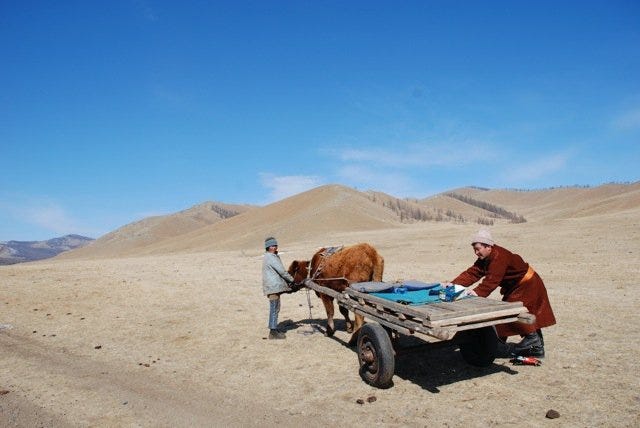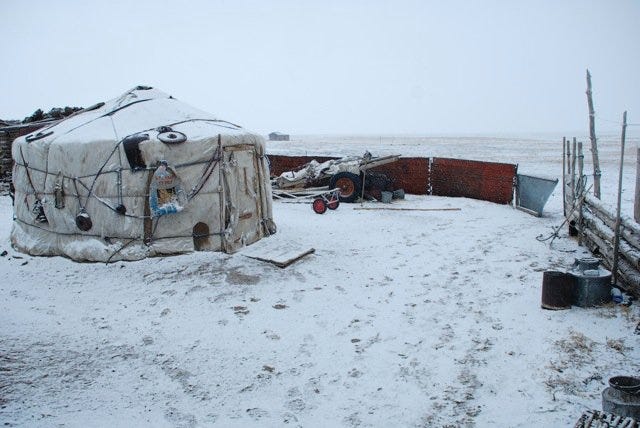This Season is a Dzud...
Mongolia in the grip of unique extreme weather phenomenon
I don’t know about you but I’ve noticed a pattern with this week’s new stories about disasters and climate change.
There are droughts in southern Africa, which have been exacerbated by the El Niño weather pattern, and deluges, caused by unprecedented rains, in Dubai.
Perhaps this is a classic case of projection, because for this week’s Thin Ink, I also want to talk about a weather condition starting with ‘d’: dzud.
I came across this phenomenon exactly 14 years ago when I was on a dream trip traversing across Mongolia, whose countryside has some of the clearest skies I’ve ever seen in my life. It also has some of the most breathtaking views I’ve ever had from a makeshift toilet.
But that 10-day journey also showed me the heartbreaking impacts the 2009-2010 dzud, one of the most severe in Mongolia’s history, had on its people, some of the friendliest I’ve ever met.
I haven’t had a chance to go back, but dzud has been back at least six more times, including this winter.
What’s a Dzud?
It is an extreme weather condition peculiar to landlocked Mongolia, a country known for its eternal blue skies and a vast, unspoiled wilderness. It occurs when a summer drought is followed by a harsh winter.
We’re talking temperatures of −30°C or lower and strong winds, heavy snow and ice, which leaves its animals with very little food. This combination of malnutrition and cold stress then causes widespread deaths among the livestock which herding families rely on for food, transport and income.
During the 2009-2010 dzud, the country lost around 10.3 million animals, approximately 25% of the Mongolia’s livestock population, the U.N. said.
Why is this a problem?
Because more than 1 in 4 households, or nearly 27% of Mongolia's 3.3 million population, lives off animal herding, according to the ILO (International Labour Organization), and meat is the primary source of food. So losing livestock is akin to losing key assets and savings.
The harsh winters, the short summers, and the rocky terrain make it difficult for Mongolia, the least densely populated country in the world, to cultivate fresh fruits and vegetables. Even growing cereals, oil plants, and potatoes is a challenge.
One of my enduring memories of Mongolia was the delight on our hosts’ faces when we turn up with tomatoes and leafy greens in our hands. We stayed with at least half a dozen Mongolian families in their homes during our trip, and I don’t remember any of them not being happy at receiving fresh produce.
What happened this year?
“This 2023-2024 winter has seen the highest snowfall recorded in the last 49 years. At its peak, 90% of the territory of Mongolia was covered with thick layers of snow,” said the World Heath Organization.
The icy conditions, not observed since the 2010 dzud, obstructed livestock’s access to pasture. As of Mar 25, 5.2 million animals - 8.1% of total livestock in the country - have already died. but aid agencies say, “The worst is yet to come, the peak of livestock mortality is expected at the end of April.”
Over 2,000 households have lost more than 70% of their livestock. This includes the Khurelbaatar family whose herd had dwindled from over 400 at the start of winter to less than 100, said the Red Cross.
The U.N. is raising $13.7 million to help some 76,000 people out of 200,000 who are in need. So far, only a third is funded. The largest requirement - $7.9 million - is for food security and agriculture and will fund unconditional cash transfers, food aid, health kits, and vitamin and mineral supplements for weakened animals.
What are some of the indirect impacts of dzud?
Malnutrition of herding households, particularly of children, is a major concern, because the extreme weather conditions disrupt the provision of healthcare just when the economic fallout from dzud makes them even more necessary.
Children may also drop out of school and end up working to help their parents. Mongolia is a growing country but it is still a developing one with a fairly high level of poverty - 27.8% in 2020 - so an event like dzud can really devastate livelihoods.
The growing frequency of dzuds has also resulted in mass migration of out-of-work nomadic herders to Mongolia's capital Ulaanbaatar, where about 45% of the country’s total population already lives. This has put a strain on the city and led to the formation of “ger districts”.
These are makeshift neighbourhoods named after the traditional yurt dwellings, where the inhabitants burn coal, tires and household waste to keep warm, creating massive pollution problems. The result is that migrants become stuck in a cycle of poverty they can’t get out of.
How often does it occur?
In a 2017 interview, Nordov Bolormaa, then-secretary-general of the Mongolian Red Cross, told me she grew up with a traditional Mongolian saying - that when the year of the monkey comes around once in each 12-year lunar calendar, it invites disasters like the dzud.
But Mongolia has experienced seven dzuds over the past 27 years, she said. "This traditional understanding and preparedness is changing.”
There have been four dzuds in the past seven years alone.
Of course, the more often it occurs, the less time there is for herding families to recover their losses.
Is it linked to climate change?
Yes.
Scientists and aid workers say climate change is not only making dzuds more frequent but is also contributing to conditions that will make dzuds worse.
“Warmer summers mean more droughts and less pasture growth. With scarce grazing opportunities, livestock are unable to amass the critical fat reserves needed to endure the punishing winter months. And in the winter months, temperature fluctuations cause thaw-and-refreeze cycles that create an ice barrier, preventing animal access to food,” said this blog co-authored by the UNDP Mongolia Resident Coordinator and UNDP Regional Director for Asia and the Pacific.
According to the Mongolian government’s Nov 2023 report to the United Nations Framework Convention on Climate Change (UNFCCC), the country has seen an annual average air temperature increase of 2.46°C degree over the past 83 years and more than 70% of its total territory is currently classified as degraded and affected by desertification.
Further reading on dzud
- In Mongolia, a Killer Winter Is Ravaging Herds and a Way of Life (Yale Environment 360)
- A Harsh Mongolian Winter Leaves Millions of Livestock Dead (The New York Times)
Thin’s Pickings
Is There Such a Thing as “Better” Meat? It’s Complicated - World Resources Institute
How do we solve a problem like animal agriculture, considering their contribution to greenhouse gas emissions, deforestation, and water usage, but also taking into account the welfare of animals, our personal and cultural preferences, and the nutrition they can provide, particularly for low-income families?
Well, not with a single solution, that’s how. This article from the authors of a new analysis tackles the difficult topic, looks at the pros and cons (what’s better for the animals might not be better for the planet), and weighs the tradeoffs.
“There is no single way to produce meat and dairy that’s “better” for all environmental, social, ethical and economic considerations. Trade-offs abound. But there are ways to minimise these trade-offs,” the authors wrote.
One way to do this is for “any food provider wishing to serve “better” meat is to go beyond just sourcing less meat to sourcing even less meat.”
If you want the full whack, here’s the link to the 76-page report.
Something Is Killing Saint Helena’s Cloud Forest - Hakai Magazine
Kevin Gepford on the “rare and beautiful cloud forest ecosystem” of Saint Helena, a remote island in the South Atlantic Ocean, which has come under threat from one of the world’s most feared plant pathogens.
The island’s once-rich biodiversity has already been irrevocably altered by “500 years of forestry, intensive farming, and destruction by introduced goats”. Will Phytophthora, also known as water molds and triggered the Irish potato famine of the mid-1800s, finish it off?
As always, have a great weekend and please feel free to share this post and send tips and thoughts on mastodon @ThinInk@journa.host, my LinkedIn page, twitter @thinink, or via e-mail thin@thin-ink.net.







This is such a powerful piece. Than you for sharing this.